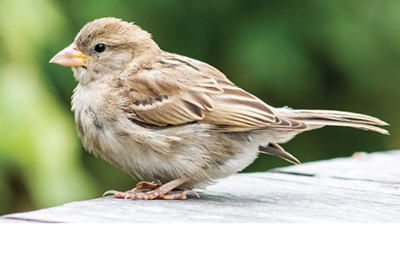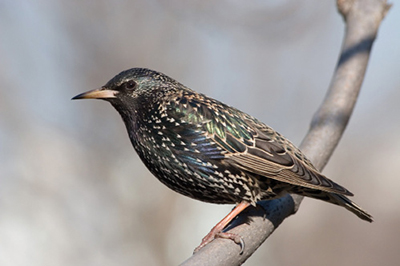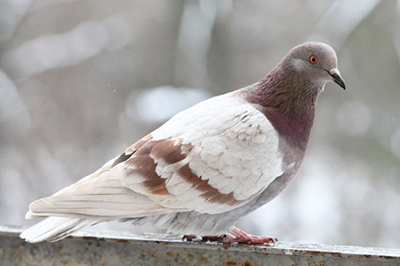Guide L-212
Revised by Sam Smallidge
College of Agricultural, Consumer and Enviromental Sciences, New Mexico State University
Author: Extension Wildlife Specialist, Department of Extension Animal Sciences and Natural Resources,
New Mexico State University. (Print Friendly PDF)
Introduction
House sparrows, starlings, and pigeons can cause problems for people in urban and suburban areas of New Mexico. Although all three species are common throughout the state, none are native to New Mexico.
There are a variety of health concerns and damage issues associated with house sparrows, starlings, and pigeons. They can transmit diseases to humans and are host to a variety of parasites and insect pests. For example, Salmonella is found in about 2% of pigeon feces and accounts for frequent cases of food poisoning in humans. Pigeon nests can also create fire hazards and clog drainpipes. Droppings can deface and ruin property as well. In addition, starlings compete for nesting sites with native cavity-nesting birds, such as bluebirds, flickers, and woodpeckers.
Identification

Figure 1. Female English or house sparrow. (Juha Remes | Dreamstime.com)
House Sparrow. The English or house sparrow (Passer domesticus) is a brown, chunky bird about 5 3/4 inches long (Figure 1). The male has a distinctive black throat, white cheeks, a gray crown, and chestnut-colored feathers on the upper wings. The female and young have plain, dingy-gray breasts; distinct, buffy eye stripes; and streaked backs.
The house sparrow, introduced from Europe, has spread across the United States and is found almost everywhere in New Mexico. It is an aggressive, adaptable bird that nests in or around manmade structures, such as building vents and window ledges, as well as in trees.
Although house sparrows are primarily grain eaters, sparrows in urban areas have adapted to feed at garbage cans, backyard bird feeders, and home gardens.

Figure 2. European starling. (Iouri Timofeev | Dreamstime.com)
Starling. European starlings (Sturnus vulgaris) are about the same size as a robin and have short, square tails. They are generally chunky and hump-backed in appearance. The wings have a triangular shape when outstretched in flight. Adults are mostly black with light, iridescent speckles of color on the feathers (Figure 2). The bill of both sexes is yellow during the reproductive cycle (January to June) and dark at other times.
The starling was introduced to New York from Europe in the late 1800s, and now occupies the entire country. It is an aggressive, adaptable bird, common in urban and suburban areas. It nests in any suitable hole or cavity in birdhouses, buildings, and trees.
Starlings eat a variety of foods, but prefer seeds and fruits. They also feed on insects during the spring and summer when insects are numerous.

Figure 3. Pigeon. (Sergey Kichigin | Dreamstime.com)
Pigeon. The pigeon or rock dove (Columba livia) typically has a bluish gray body and wings, a dark head, a whitish rump, two dark wing bars, and a broad black band on the tail (Figure 3). Body color can vary from gray to white, tan and black. It weighs approximately 13 ounces and is about 11 inches long.
The pigeon was introduced from the Old World and is now found throughout the United States. In fact, pigeons are very common in many urban and suburban areas of New Mexico. Pigeons are highly dependent on humans for food and roosting, loafing, and nesting sites. They are commonly found around farms, grain elevators, feed mills, parks, city buildings, bridges, and other structures.
Pigeons are primarily grain and seed eaters. However, they also feed on garbage, insects, and food materials provided by people.
Damage Prevention and Control Methods
Controlling nuisance birds can be both difficult and frustrating. The most effective way to control problem birds is to remove or exclude them from their daily requirements of food, water, shelter, and space. A variety of methods will be discussed to help homeowners control nuisance birds and prevent bird damage. Remember, it often is necessary to use a variety of methods simultaneously to control nuisance birds because birds easily become accustomed to single control practices.
Habitat Modification. In some cases, homeowners may reduce the number of nuisance birds by choosing plants that do not produce edible nuts, fruits, or berries. However, in many cases this may not be practical. Trimming and pruning trees and shrubs also may decrease the amount of available nesting and roosting habitat. Thinning roosting trees and shrubs often does not need to be dramatic in order to be effective.
Changing the type of food offered in bird feeders can reduce the number of undesirable birds. For example, house sparrows are often a problem at bird feeders. To reduce their numbers, feed them straight sunflower seeds (preferably the black, oil-type) instead of a seed mixture. Using tubular feeders without perches also makes it more difficult for house sparrows and large birds to feed. In some cases, homeowners may need to discontinue feeding altogether in the spring, summer, and early fall.
Water sources also attract birds, particularly starlings. Therefore, where starlings are a problem, removing unnecessary water may be effective.
Exclusion. Pigeons, starlings, and house sparrows can be excluded from entering buildings and other structures by blocking access to indoor roosts and nesting areas. Close all openings greater than 3/4 inch to exclude house sparrows and 1 inch to exclude starlings. Openings to lofts, steeples, vents, and eaves should be blocked with plywood, sheet metal, masonry, 1/4-inch wire mesh, or plastic or nylon netting.
Hanging vinyl door strips from barn and shed doorways will also prevent most birds from entering the structure while still allowing people, machinery, and livestock to pass through.
Various methods are available to prevent birds from nesting or roosting on ledges and rafters, under eaves, and on other overhangs.
- Nylon or plastic netting can be attached to the underside of rafters or overhangs to keep birds out. Netting also is useful for covering fruit crops, such as grapes, to prevent birds from roosting or eating the fruit (Figure 4).
- Bird spikes, bird coils, and bird spiders can be used to deter birds from nesting or roosting on ledges, rafters, or other structures (Figure 5). Bird spikes are made of plastic or steel prongs extending outward at angles. They commonly come in different widths. Bird coils are made of plastic, wire cable, or wire and function similarly to birdspikes. Bird spikes and coils deter large birds from landing on surfaces they are applied to. In some cases, nesting material, such as twigs and grass, must be removed from the “porcupine wires” in order to maintain their effectiveness. Bird spiders are made of plastic and wire with wire legs arcing up and out from a central point. Bird spiders are effective for keeping large birds from roosting on structures such as heating and cooling units. Bird spiders typically come in different diameters to cover up to approximately ten feet.

Figure 4. Netting can be used to keep birds out of rafters and trees (Lee and Henderson, 1992).

Figure 5. Bird spikes (top), coils (middle), and spiders (bottom) can be used to prevent birds from roosting on various structures.
Frightening Devices. Frightening devices include alarm and distress calls, exploding shells, automatic gas exploders, tethered balloons with big eyes painted on them, hawk silhouettes, water sprayers, aluminum pie plates, and flashing lights. In some cases, these devices repel starlings and other birds, such as crows and blackbirds, from roosts and small-scale fruit crops. However, frightening devices have little or no effect on house sparrows and pigeons. Using both visual scare devices and noisemakers seems to be most effective. However, both visual and sound devices must be moved frequently or the birds will become accustomed to them. In addition, it often takes five to seven nights or more of continuous effort for frightening programs to be effective.
Repellents. Soft, sticky repellents, such as Bird Tanglefoot and 4-The-Birds, consist of nontoxic materials that can be used to discourage birds from roosting on areas likes ledges and roof beams. It is helpful to first put masking tape on the surface that needs protection, and then apply the repellent onto the tape. This increases the effectiveness of the sticky repellents on porous surfaces and makes for easier removal. However, these repellents are messy, collect dirt, and need to be reapplied several times a year. Also, a bird’s ability to maintain their body temperature can be reduced if they preen these substances into their feathers.
Trapping. Live trapping is another alternative for controlling nuisance birds. Live trapping methods include funnel traps, automatic and triggered traps, nest box traps, decoy traps, and mist nests. With these methods, protected songbirds can be released unharmed.
When using live traps, pre-bait the area without a trap, or around the outside of the unset trap, for one to two weeks. Common baits include cracked corn or milo. Then set the trap with the same bait inside. Be sure to check the traps several times each day so nontarget birds can be released unharmed and the number of birds that might find a way to escape is reduced.
Be sure to terminate house sparrows, starlings, or pigeons caught in the trap in a humane manner. Wear appropriate personal protective equipment when handling birds. Releasing the birds back to the “wild” often is impractical. For example, pigeons are likely to return even when released 50 miles or more from the problem site, and they can become problems in other communities. Because some cities and towns require special permits, also check with local animal control or wildlife conservation officers for bird trapping regulations.
Other Control Methods. Where local ordinances permit, some success for controlling pigeons and house sparrows can be achieved with persistent shooting. For example, shooting can be an effective technique to remove a few pigeons around farms or grain elevators. For starlings, however, shooting is more effective as a dispersal technique than as a way to reduce numbers.
Removing nests every two weeks during the spring and summer can sometimes help reduce pigeon and house sparrow populations. A long pole with a hook attached to the end is an effective tool for reaching nests under rafters or eaves. Be persistent because the birds will keep trying to reestablish their nests in the same location. The nests should be collected and removed to eliminate nesting material for rebuilding. Make sure you are not disturbing a nest of a protected species. This technique should be used in conjunction with other control methods.
Acknowledgments
Much of the information in this publication was adapted from:
Fitzwater, W.D. 1994. House sparrows. In The handbook: Prevention and control of wildlife damage (pp. E-101–E-108). Lincoln: University of Nebraska.
Johnson, R.J., and J.F. Glahn. 1994. European starlings. In The handbook: Prevention and control of wildlife damage (pp. E-109–E-120). Lincoln: University of Nebraska.
Lee, C., and F.R. Henderson. 1992. Birds, urban wildlife damage control [L856]. Manhattan: Kansas State University Cooperative Extension Service.
Texas Wildlife Damage Management Service. 1998. Controlling roosting birds in urban areas [L-1921]. San Antonio: Author.
Texas Wildlife Damage Management Service. 1998. Controlling house sparrows [L-1920]. San Antonio: Author.
For further reading
L-202: Bats in Buildings: Proper Exclusion Techniques in New Mexico
https://pubs.nmsu.edu/_l/L202/
L-209: Rodent Control and Protection from Hantavirus
https://pubs.nmsu.edu/_l/L209/
L-211: Controlling Nuisance Woodpeckers in New Mexico
https://pubs.nmsu.edu/_l/L211/
| Brand names appearing in publications are for product identification purposes only. No endorsement is intended, nor is criticism implied of similar products not mentioned. Persons using such products assume responsibility for their use in accordance with current label directions of the manufacturer. |
| Original authors: Jon Boren, Extension Wildlife Specialist; and Brian J. Hurd, Extension Research Specialist. |

Sam T. Smallidge is the Extension Wildlife Specialist at New Mexico State University. He has degrees in wildlife and range management. His Extension program focuses on wildlife damage management, wildlife enterprises, and wildlife ecology and management education for youth and adults.
To find more resources for your business, home, or family, visit the College of Agricultural, Consumer and Environmental Sciences on the World Wide Web at pubs.nmsu.edu
Contents of publications may be freely reproduced for educational purposes. All other rights reserved. For permission to use publications for other purposes, contact pubs@nmsu.edu or the authors listed on the publication.
Brand names appearing in publications are for product identification purposes only. No endorsement is intended, nor is criticism implied of similar products not mentioned. Persons using such products assume responsibility for their use in accordance with current label directions of the manufacturer.
New Mexico State University is an equal opportunity/affirmative action employer and educator. NMSU and the U.S. Department of Agriculture cooperating.
February 2017


